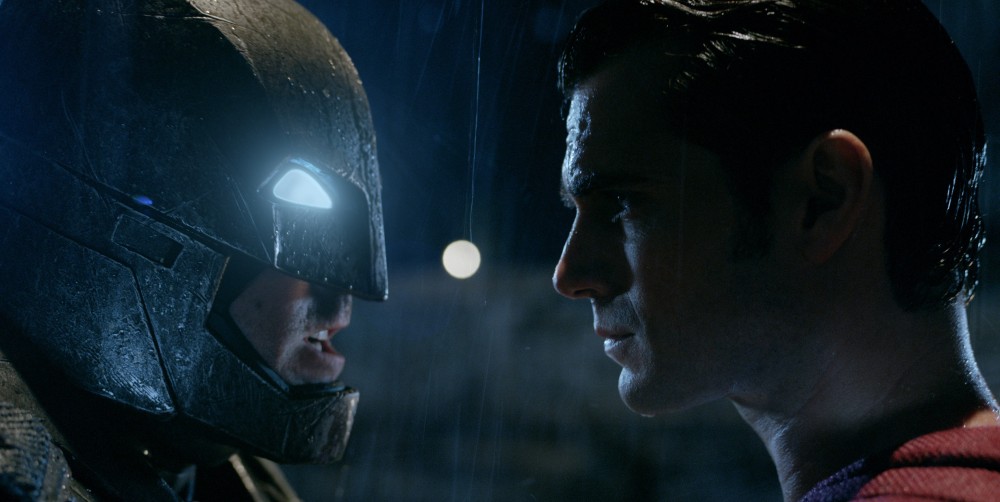
Trudging through the swamp that is Man of Steel is a hell of a struggle, which made the worry that Batman v Superman: Dawn of Justice might be more of the same all the greater. Lucky enough for viewers cautious of its behemoth length, it’s a movie that actually proves rather entertaining and well-paced when compared to its prequel of sorts. That said, the latest entry in the DC Cinematic Universe shows that Warner Bros. are still finding their footing, and it’s going to take a lot more than Chris Terrio and Ben Affleck to fix everything David Goyer and Zack Snyder have already gotten wrong.
Dawn of Justice forwards us nearly two years past the attack on Metropolis that Man of Steel climaxed with. After all the complaining that audiences and critics alike made about Superman’s disregard for human safety in the city, it was obvious that this would be used as a launching pad for a narrative. And it is! A fair amount of political discussion alongside debates on whether Superman is a God among us ensues, but never really goes anywhere, as social commentary takes a back seat to action.
This isn’t uncommon in comics, as well as their on-screen adaptations, but when filmmakers draw from themes and works of literature rich with possibility to kick off a conversation deeper than “is Batman cooler than Superman,” one expects more. The plot is a bit of a convoluted mess, but here’s a simple breakdown: Batman finds Superman intolerable; Superman finds Batman’s vigilantism deplorable; Lex Luthor manipulates everyone around him to do some bad, but fucks it all up; Batman and Superman fight; some other characters get in the way. I’d tell you people learn about the meaning of friendship, but this isn’t The Avengers.
A distinct lack of interest in characterization is the biggest problem with Dawn of Justice. Every woman with a speaking role has been reduced to something barely present; someone to die, someone to be rescued, or someone to move the plot along or offer Easter eggs for the future. For all the hype around Wonder Woman’s first appearance, she spends all of her screen time without an ounce of personality, servicing the narrative with a just a dash of fighting and lassoing. Worse than that, if it’s possible, is the film’s penchant for pretending that Lois Lane has some agency (“I’m not a lady; I’m a journalist”) and then stealing it away from her by making her someone to be saved time and time again (which was a problem that MoS also featured).
This ties directly into the disappointment that is Lex Luthor as a villain. Rather than take a page from Lex Luthor: Man of Steel — a rather impressive comic by Brian Azzarello that characterizes Luthor as more than a common villain — Snyder, Goyer, and Terrio turn him into a maniac akin to the Riddler (without riddles) or the Joker (without face paint). Certainly many will say that one shouldn’t expect screen to match page, but considering Snyder’s fetish for drawing visual inspiration from the pages these characters were born on, one would hope the writers would take notes from stories that already work. He fits well enough in the petulant millennial trope that many blockbusters have tried exploring recently (Star Wars: The Force Awakens and Fantastic Four among them), but his characterization, and Eisenberg’s performance, comes across as completely out of place against Henry Cavill’s Clark Kent and Ben Affleck’s Bruce Wayne.
And so we come to the good of the film. Looking past a shoddy script that still somehow works better than the ungodliness that was Man of Steel, the conflict between Batman and Superman actually works, to an extent. Snyder feels more comfortable behind the camera here than he did with his former DC film, aiming more for building tension and framing these two individuals planning on taking on forces they’re unfamiliar with instead of trying to establish any unnecessary intimacy with them. This isn’t to say that certain moments don’t feel like a hammer to the skull though, particularly watching Martha and Thomas Wayne die for the hundredth time.
Where Snyder seems most comfortable is in the mundanity of humanity; loaded conversations between politicians (with Holly Hunter proving rather memorable, if underused), minor characters simply going through the motions (Jeremy Irons’ Batbutler Alfred and Laurence Fishburne’s Daily Planet editor standing out), and even two people dealing with relationship problems (with Adams and Cavill working beautifully yet again). As entertaining as some of the fight sequences are — though the “final battle” comes across as endless and heavy on the CGI — there’s a messiness to the editing that works against the film. But, even when bashing each other and those around them to a pulp, Henry Cavill and Ben Affleck maintain a natural chemistry from start to finish that solidify a sense of interest in what happens to their characters.
Much of the purpose of Dawn of Justice seems to be building a bridge between Man of Steel, the beginning of DC’s Cinematic Universe, and the inevitable Justice League. While Batman v Superman: Dawn of Justice isn’t necessarily a bad movie and will offer plenty of thrills to those watching it, it does prove that the people behind it don’t have an inkling of how to make the audience care about any character that isn’t in the title. That, and the fact that no one knows how to make a superhero movie that doesn’t feel too long for its own good, is the problem.
—
Directed by Zack Snyder; written by Chris Terrio and David Goyer; starring Ben Affleck, Henry Cavill, Amy Adams, Gal Gadot, Diane Lane, Jesse Eisenberg, Laurence Fishburne, Jeremy Irons, Holly Hunter, Scoot McNairy; 151 minutes.
Batman v Superman: Dawn of Justice opens in theaters everywhere.



 Derek
Derek
 Isabelle
Isabelle